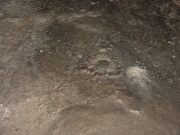Calcite (Inventory)/Splash Ring
From LagWiki
| Line 10: | Line 10: | ||
Splash rings are very round when the floor is flat. If the floor has a slope, they will take on an eliptical shape. The ring could be partially obstructed and thus may not form a complete circle. | Splash rings are very round when the floor is flat. If the floor has a slope, they will take on an eliptical shape. The ring could be partially obstructed and thus may not form a complete circle. | ||
| - | Look for splash rings on the floor especially when the floor material is soft | + | Look for splash rings on the floor especially when the floor material is soft. |
==References== | ==References== | ||
Revision as of 16:49, 30 April 2011
The Splash Ring field is used to record stations where cave rings appear.
Splash rings (also known as cave rings) are noticeable rings of calcite usually around a central splash point. There are two identified mechanisms for splash ring development. There is no need to identify the mechanism on the form; but, they can usually be identified by the diameter of the ring and the presence or absense of a central, hollow stalagmite.
The first and most common mechanism is when drips of water strike a soft floor surface such as sediment or guano. If there is sufficient height, the drips may form a depression and splash outward depositing their minerals in a circle around the splash point. A central stalagmite may form at the same time. This type of splash ring is almost always between 0.8 and 2 meters in diameter.
The second mechanism is experimentally demonstrated to be when droplets fall and separate into smaller droplets on their way to the floor. This mechanism forms much smaller rings and may not have a central splash point; but, a small mound or stalagmite in the center.
Splash rings are very round when the floor is flat. If the floor has a slope, they will take on an eliptical shape. The ring could be partially obstructed and thus may not form a complete circle.
Look for splash rings on the floor especially when the floor material is soft.
References
- Hill, Carol; Paolo Forti (1997) Cave Minerals of the World (Second Edition ed.) National Speleological Society pp 94-95 ISBN: 1-879961-07-5

